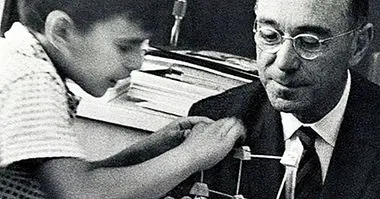Psychology of envy: 5 keys to understanding it
"I wish I had it too", "I should have gotten it", "Why he / she and I do not?" These and other similar phrases have been thought and expressed by a large number of people throughout their lives.
All of them have one element in common: they express the desire to possess something that is not possessed by oneself and if by others . In other words, all these expressions refer to envy. Then proceed to make a brief analysis of the meaning of envy, as well as what some research reflects on it.
Defining envy
When we talk about envy we refer to a feeling of pain and frustration due to the non-possession of a property, characteristic, relationship or desired event that we would like to have and another person does possess, seeing this situation as unfair.
Thus, we can consider that for envy to appear, there are three basic conditions, the first being that there must be someone alien to the individual who possesses a good, characteristic or concrete achievement, the second that this phenomenon, characteristic or possession is object of desire for the individual and finally, the third condition is that a feeling of discomfort, frustration or pain appears before the comparison between the two subjects.
The feeling of envy is born of another feeling, that of inferiority, before the comparison between subjects. In general, feelings of envy are directed towards people who are in levels and strata relatively similar to their own, since individuals very far from their own characteristics do not usually awaken the sense of inequality that someone with circumstances similar to those of oneself.
Considered one of the seven deadly sins by various religious confessions, this feeling implies a focus on the characteristics of others, ignoring their own qualities . It is an obstacle to the establishment of a healthy relationship, undermining interpersonal relationships, as well as the maintenance of positive self-esteem.
1. Different types of envy
However, one wonders if envy is the same in all people, it seems that it has a negative response.
This is due to what is known as healthy envy. This term refers to a type of envy centered on the envied element, without wishing any harm to the person who owns it. On the other hand, pure envy supposes the belief that we are more deserving of the object of desire than the one we envy, and joy can be produced in the face of its failure.
2. Disadvantages to consider
Envy has traditionally been conceptualized as a negative element, due to the deep discomfort that it causes together with the hostile relationship it implies towards other people, which is related to lack of self-esteem and the fact that it comes from the feeling of inferiority and inequity. Likewise, according to numerous studies envy can be behind the existence and the creation of prejudices .
Likewise, envy towards other people can cause defensive reactions to appear in the form of irony, mockery, hetero-aggressiveness (ie aggressiveness directed at other people, be it physical or psychological) and narcissism. It is common for envy to turn into resentment, and if it is a prolonged situation over time it can induce the existence of depressive disorders. In the same way it can induce feelings of guilt in people who are aware of their envy (which correlates with the desire that the envied go badly), as well as anxiety and stress.
3. Evolutionary sense of envy
However, even though all these considerations are scientifically based, Envy can also be used in a positive way .
Envy seems to have an evolutionary sense: this feeling has driven the competition for the search of resources and the generation of new strategies and tools, elements that have been essential for survival since the beginning of humanity.
Also, in this sense envy makes a situation that we consider unjust can motivate to try to reach a situation of equity in areas such as labor (for example, it may lead to struggle to reduce wage differences, avoid favorable treatment or establish clear promotion criteria).
4. Neurobiology of envy
Reflecting on envy can lead to wondering, And what happens in our brain when we envy someone?
This reflection has led to the realization of various experiments. Thus, in this sense a series of experiments carried out by researchers from the National Institute of Radiological Sciences of Japan have indicated that in the face of the feeling of envy, various areas involved in the perception of physical pain are activated at the brain level.In the same way, when volunteers were asked to imagine that the envied subject suffered a failure, the release of dopamine in cerebral areas of the ventral striatum was triggered, activating the cerebral reward mechanism. In addition, the results show that the perceived intensity of envy correlated with the pleasure obtained by the failure of the envied.
5. Jealousy and envy: fundamental differences
It is relatively frequent, especially when the object of desire is a relationship with someone, that envy and jealousy are used indistinctly to refer to the feeling of frustration that causes not enjoy that personal relationship.
The reason that envy and jealousy are often confused is that they usually occur jointly . That is, jealousy is given to people who are considered more attractive or qualities than oneself, with which the alleged rival is envied. However, these are two concepts that, although related, do not refer to the same.
The main difference is found in that while envy is given regarding an attribute or element that is not possessed, jealousy occurs when there is fear of the loss of an element with which it was counted (usually personal relationships). Also, another difference can be found in the fact that envy occurs between two people (envied and subject who envies) with respect to an element, in the case of jealousy a triadic relationship is established (person with jealousy, person with respect to the that they are jealous and third person that could snatch the second). The third difference would be in the fact that the lattice comes together with a sense of betrayal, while in the case of envy this does not usually happen.
Bibliographic references:
- Burton, N. (2015). Heaven and Hell: The Psychology of the Emotions. United Kingdom: Acheron Press.
- Klein, M. (1957). Envy and gratitude. Buenos Aires. Paidos.
- Parrott, W.G. (1991). The emotional experiences of envy and jealousy, The psychology of jealousy and envy. Ed. P. Salovey. New York: Guilford.
- Parrot, W.G. & Smith, R.H. (1993) .Distinguishing the experiences of envy and jealousy. Journal of Personality and Social Psychology, 64.
- Rawls, J. (1971). A Theory of Justice, Cambridge, MA: Belknap Press.
- Schoeck, H. (1966). Envy: A Theory of Social Behavior, Glenny and Ross (trans.), New York: Harcourt, Brace
- Smith, R.H. (Ed.) (2008). Envy: Theory and research. New York, NY: Oxford University Press.
- Takahashi, H .; Kato, M .; Mastuura, M .; Mobbs, D .; Suhara, T. & Okubo, Y. (2009) .When Your Gain Is My Pain and Your Pain Is My Gain: Neural Correlates of Envy and Schadenfreude. Science, 323; 5916; 937-939.
- Van de Ven, N .; Hoogland, C.E .; Smith, R.H .; van Dijk, W.W .; Breugelmans, S.M .; Zeelenberg, M. (2015). When envy leads to schadenfreude. Cogn.Emot .; 29 (6); 1007-1025
- West, M. (2010). Envy and difference. The Society of Analytical Psychology.



















